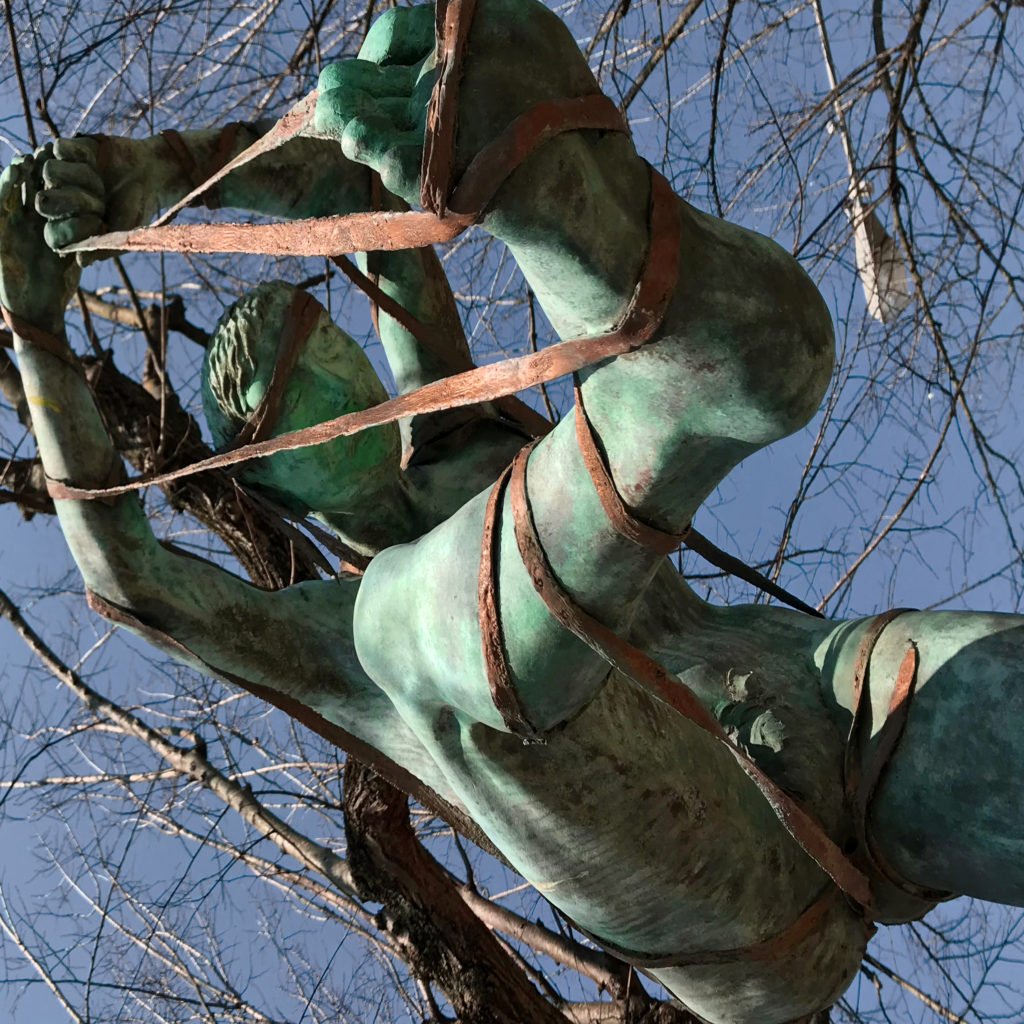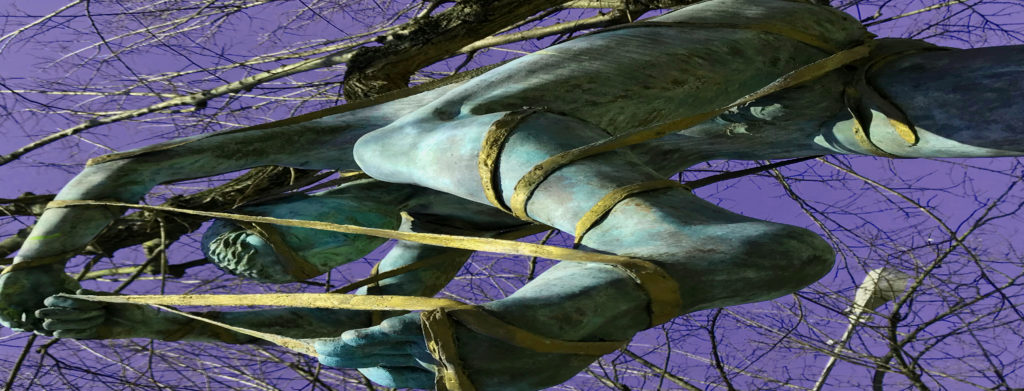smoke ‘n’ mirrors
 I am totally discombobulated. Never have I read a book that I didn’t have enough of a grasp to either criticize or praise it. This one’s got me struggling to straighten out the curlicues in my thoughts.
I am totally discombobulated. Never have I read a book that I didn’t have enough of a grasp to either criticize or praise it. This one’s got me struggling to straighten out the curlicues in my thoughts.
Debt: The First 5000 Years, David Graeber, has as much to say about value, honor, and social status as it does debt. In fact, as his thesis develops we find debt’s entanglement with these concepts becoming murkier, and a trump card that buries it all. At the heart of his analysis of debt is the stratification of society that occurred simultaneously with surplus food, and the need to account for the surpluses; writing, not to record knowledge but to keep accounts; and money, a standard unit of value for the accounting. He points out early on that this isn’t the economic theory we’ve been indoctrinated into, quite the contrary, it’s a theory based on anthropological evidence instead of Adam Smith’s making up history to support his wishful thinking of the “invisible hand” nonsense. Smith’s invisible hand is, rather, the facts he ignored or never investigated. This, though, is a minor shake up compared to the underlying message : debt=wealth=social status. Social status is built upon honor. Honor is an intangible that cannot be counted. Although, honor is a human given as every individual has inherently a unit of honor. It can, however, be taken away or given up. When this happens, honor goes from one person to another—the giver’s (loser’s) honor gets tacked onto the receiver’s (winner’s). This creates a debt. But who owes whom?
Here we have a problem. It’s easy to see how status equates with wealth, but debt? Then, add to the mix this conundrum — “If you owe the bank a hundred thousand dollars, the bank owns you. If you owe the bank hundred million dollars, you own the bank.”
 And neither does this explain money—that unit of exchange that stands in place of value. Money, as he explains, was originally used not for daily needs, but for symbolic exchange, such as weddings, or exchange with strangers. Like poker chips—measured, counted, and coveted; like gold, silver, gems, or as in some cultures shells or beads, all are objects of symbolic value—but highly coveted. Money is a surrogate. We think of gold and silver as having “real” value. Really? You can’t eat gold, or heat your house, or clothe yourself, or fulfill any basic need with it. Its value is symbolic. Its power is given to it by our belief that it has value and that others value it the same. It was used for buying honor, that is, the buying and selling of people—things that are impossible to put a quantitative value on.
And neither does this explain money—that unit of exchange that stands in place of value. Money, as he explains, was originally used not for daily needs, but for symbolic exchange, such as weddings, or exchange with strangers. Like poker chips—measured, counted, and coveted; like gold, silver, gems, or as in some cultures shells or beads, all are objects of symbolic value—but highly coveted. Money is a surrogate. We think of gold and silver as having “real” value. Really? You can’t eat gold, or heat your house, or clothe yourself, or fulfill any basic need with it. Its value is symbolic. Its power is given to it by our belief that it has value and that others value it the same. It was used for buying honor, that is, the buying and selling of people—things that are impossible to put a quantitative value on.
There’s no longer any question about the ownership of a person. There should be a new question, a question of the ownership of global resources—oil, forests, fresh water, farm land, minerals. It’s from the concept of ownership that debt arises, in part. In part, debt is something we all trade in everyday with and without money, with or without keeping accounts.
But if I understand debt correctly, it’s not any more real than money. It’s a ruse to justify taking more resources than one’s fair share, and to foist on the debtor the guilt of having been cheated out of their share, their honor, out of their human dignity. It’s the makings of a slave. Debt, like money, is an artifice, imaginary. And like money, can be created out of nothing.
Finding a good explanation of how debt, or money, is created out of nothing is foggy. There is one recurring reason cited, war. The conquered survivors are “indebted“ to the victors for their lives. They become slaves or subjects who owe the victors tribute—their labor or resources being the interest due on the debt.
The immediate effects of the advent of the free-floating dollar, then, marked not a break with the alliance of warriors and financiers on which capitalism itself was originally founded, but on something that looks a lot more like its ultimate apotheosis. Neither has the return to virtual money led to a great return to relations of honor and trust: quite the contrary. But we are talking about the very first years of what is likely to be a centuries-long historical era. By 1971, most of these changes had not even begun. The American Express card, the first general-purpose credit card, had been invented a mere thirteen years before, and the modern national credit-card system had only really come into being with the advent of Visa and Mastercard in 1968. Debit cards came later, creatures of the 1970s, and the current largely cashless economy only came into being in the 1990s. All of these new credit arrangements were mediated not by interpersonal relations of trust but of profit-seeking corporations, and one of the earliest and greatest political victories of the U.S. credit-card industry was the elimination of all legal restrictions on what they could charge as interest.
If history holds true, an age of virtual money should mean a movement away from what was, empire-building, slavery, and debt peonage (waged or otherwise), and toward the creation of some sort of overarching institutions, global in scale, to protect debtors. What we have seen so far is the opposite. The new global currency is rooted in military power even more firmly than the old was. Debt peonage continues to be the main principle of recruiting labor globally: either in the literal sense, in much of East Asia or Latin America, or in the subjective sense, whereby most of those working for wages or even salaries feel that they are doing so primarily to pay off interest-bearing loans.
We run into a giant contradiction when the concept of property ownership is extended to human rights. Can our freedom be bought and sold, lent and rented, given up or given away? This may seem like a rhetorical question, but it is serious. History is replete with slavery and indentureship. Although those terms are not used much today in advanced countries. They’ve been replaced by the term employment, in effect a “free choice” version of the former methods. Now the question becomes, how ethical is employment? How free is an employee? Is it a temporary form of slavery?
And I have more questions. If debt were erased from the economic lexicon, would there be property ownership or wealth? If there were no ownership of anything except human rights, inalienable human rights, own-able only by oneself, how would an economy be built on human rights?
He returns to war as the cause and need for money, as opposed to credit, and to precious metals as a convenient, portable symbol of value. War was all about pillaging others’ recourses and treasures. Supplying the war machine and paying the soldiers led to the need for a common unit of exchange, i.e.,money—something to covet, to get others to covet, and then, use it to get them to go along with the war games.
How did we get here? My own suspicion is that we are looking at the final effects of militarization of American capitalism itself. In fact, it could well be said that the last thirty years have seen the construction of a vast bureaucratic apparatus for the creation and maintenance of hopelessness, a giant machine designed, first and foremost, to destroy any sense of possible alternative futures. At its root is a veritable obsession on the part of rulers of the world—in response to the upheavals of the 1960s and 1970s—with ensuring that social movements cannot be seen to grow, flourish, or proposes alternatives; that those who challenge existing power arrangements can never, under any circumstances, be perceived to win. To do so requires creating a vast apparatus of armies, prisons, police, various forms of private security firms and military intelligence apparatus, and propaganda engines of every conceivable variety, most of which do not attack alternatives directly so much as create a pervasive climate of fear, jingoistic conformity, and simple despair that renders any thought of changing the world seem an idle fantasy. Maintaining this apparatus seems even more important to exponents of the “free market,” even than maintaining any sort of viable market economy. How else can one explain what happened in the former Soviet Union? One would ordinarily have imagined that the end of the Cold War would have led to the dismantling of the army and the KGB and the rebuilding of the factories, but in fact what happened was precisely the other way around. This is just an extreme example of what has been happening everywhere. Economically, the apparatus is largely just a drag on the system; all those guns, surveillance cameras, and propaganda engines are extraordinarily expensive and don’t really produce anything, and no doubt it’s yet another element dragging the entire capitalist system down—along with producing the illusion of an endless capitalist future that laid the groundwork for the endless bubbles to begin with. Finance capital became the buying and selling of chunks of that future, and economic freedom, for most of us, was reduced to the right to buy a small piece of one’s own permanent subordination.
The ensuring that social movements get nipped, early and quickly, as we have seen countless times, has been much more effective recently. This is mostly due to the huge escalation of fire power, the militarization of the police. That alternative views are squelched or ridiculed, or worse yet, simply ignored, is bolstered by the media. Graeber’s book is an example. It got some press on its release, then quickly forgotten. So did Piketty’s book.* So did the Arab Spring, Occupy Wall Street, and many other protests and demonstrations meant to get people thinking. But now the risk, the perceived risk, because we’re all invested in the system, is too high for the masses to challenge the status quo, or to ask the obvious questions, or still worse, to not allow ourselves to see the obvious—the endless waste of militarism and competition.
It [capitalism] is ultimately a system of power and exclusion, and when it reaches the breaking point, the symptoms recur, just as they had in the 1970s: food riots, oil shock, financial crisis, the sudden startled realization that the current course was ecologically unsustainable, and attendant apocalyptic scenarios of every sort.
In the wake of the subprime collapse, the U.S. government was forced to decide who really gets to make money out of nothing: The financiers, or ordinary citizens. The results were predictable. Financiers were “bailed out with taxpayer money”—which basically means that their imaginary money was treated as if it were real. Mortgage holders were, overwhelmingly, left to the tender mercies of the courts, under a bankruptcy law that Congress had a year before (rather suspiciously presciently, one might add) made far more exacting against debtors. Nothing was altered. All the major decisions were postponed. The Great Conversation that many were expecting never took place.
You may recall the talk about bailing out the mortgagors instead of the banks. You may recall the mortgagors got blamed for the bad loans made by the subprime lenders who cared less about the borrower’s ability to repay. You might also recall that it used to be the bank’s responsibility to protect itself by not making bad loans. Obviously the smart and ethical thing to do is not the profitable thing to do. After all, too small to fail just doesn’t ring well in the media.
 The questions keep nagging me. How do pretty shiny things, gold, silver, gems, useless for survival or comfort, get to be so grossly valued that people will lie, cheat, steal and murder for them? And how do they stand-in for anything of real value, or dignity, or honor? And before metals there were other prized objects used for money, things that seem extraordinarily silly to us, such as cowry shells or bird feathers. However, it doesn’t matter, only its symbolic value matters. How else do you convince someone to take a lump of silver in exchange for his cow? If you were the farmer, that cow provided milk every day. It fed your family. Its manure fertilized your fields to grow other food. Why should you be willing to trade a valuable cow for a shiny bobble? And how did metal become universally accepted and given outsized value? Why not bird feathers? How did entire populations fall for it? All that needs to be done is to mint money, or assign digital credit, and instantly, like magic, value created.
The questions keep nagging me. How do pretty shiny things, gold, silver, gems, useless for survival or comfort, get to be so grossly valued that people will lie, cheat, steal and murder for them? And how do they stand-in for anything of real value, or dignity, or honor? And before metals there were other prized objects used for money, things that seem extraordinarily silly to us, such as cowry shells or bird feathers. However, it doesn’t matter, only its symbolic value matters. How else do you convince someone to take a lump of silver in exchange for his cow? If you were the farmer, that cow provided milk every day. It fed your family. Its manure fertilized your fields to grow other food. Why should you be willing to trade a valuable cow for a shiny bobble? And how did metal become universally accepted and given outsized value? Why not bird feathers? How did entire populations fall for it? All that needs to be done is to mint money, or assign digital credit, and instantly, like magic, value created.
Then there’s the big daddy question: how is debt created? How did the concept of debt originate? He throws out a number of possibilities, none to his own satisfaction. I don’t buy them either. They all seem artificial—as artificial as money. However, one proposal keeps popping up, the standard for everyday person to person exchange is a cashless credit system whereby we each exchange whatever we make or do with others on credit—over time it basically evens out, or we settle up perceived inequalities by giving or getting something to even the score. A rather relaxed, casual system of accounting, but what does it matter? It’s based on trust and personal relationships. No one is out to get rich—there’s no point in it—unless you want to take more than your fair share. It’s all about working, living and cooperating together to mutual benefit.
As he moves on to recent times, we see money matters getting more grotesque.
All this is not to say that the people of the world were not being offered something: just that, as I say, the terms had changed. In the new dispensation, wages would no longer rise, but workers were encouraged to buy a piece of capitalism. Rather than euthanize the rentiers, everyone could now become rentiers—effectively, could grab a chunk [tidbits] of the profits created by their own increasingly dramatic rates of exploitation. The means were many and familiar. In the United States, there were 401(k) retirement accounts and an endless variety of other ways of encouraging ordinary citizens to play the market [the casino known as Wall Street] but at the same time, encouraging them to borrow. One of the guiding principles of Thatcherism and Reaganism alike were that economic reforms would never gain widespread support unless ordinary working people could at least aspire to owning their own homes; to this was added, by the 1990s and 2000s, endless mortgage-refinancing schemes that treated houses, whose value it was assumed would only rise, “like ATMs,”—as the popular catchphrase had it—though it turns out, in retrospect, it was really more like credit cards. Then there was the proliferation of actual credit cards, juggled against one another. Here, for many, “buying a piece of capitalism” slithered undetectably into something indistinguishable from those familiar scourges of the working poor: the loan shark and the pawnbroker. It did not help here that in 1980, U.S. federal usury laws, which had previously limited interest to between 7 and 10 percent, were eliminated by act of Congress. Just as the United States had managed to largely get rid of the problem of political corruption by making the bribery of legislators effectively legal (it was redefined as “lobbing”), so the problem of loan-sharking was brushed aside by making real interest rates of 25 percent, 50 percent, or even in some cases (for instance, for payday loans) up to 6,000 percent annually, the sort of numbers that would once have made the Mafia blush, perfectly legal—and therefore, enforceable no longer by just hired goons and the sort of people who place mutilated animals on their victims’ doorsteps, but by judges, lawyers, bailiffs, and police.
Interesting how important changes in the law get slipped in, or more likely, sold to us under the guise of apparently “fair” logic. We have higher paid lackeys (judges and lawyers) telling lower paid lackeys (bailiffs and police) to do the dirty work. How did this happen? Why do people give up their dignity? Why have they handed it over freely and willingly? Brute force is usually the answer.
If war, conquest and plunder, is the key to creating markets and amassing wealth, and it’s all dependent on getting masses of the population to support the scheme, through patriotism and propaganda and money, or at last resort, by the threat of force, how is it that so few people (the leaders/CEOs/bankers) can get so many people (the soldiers/police/slaves/employees) to risk their lives making hell on earth for others with only crumbs in return? What gets the masses to go along with this insanity?
They had a much more fundamental problem with the market: greed. Market motives were held to be inherently corrupt. The moment that greed was validated and unlimited profit was considered a perfectly viable end in itself, this political, magical element became a genuine problem, because it meant that even those actors—the brokers, stock-jobbers, traders—who effectively made the system run had no convincing loyalty to anything, even to the market itself.
Hobbes, who first developed this vision of human nature into an explicit theory of society, was well aware of this greed dilemma. It formed the basis of his political philosophy. Even he argued, if we are all rational enough to understand that it’s in our long-term interest to live in peace and security, our short-term interests are often such that killing and plundering are the most obviously profitable courses to take, and all it takes is a few to cast aside their scruples to create utter insecurity and chaos. This is why he felt that markets could only exist under the aegis of an absolutist state, which would force us to keep our promises and respect one another’s property.
 That quotation needs a little parsing. “. . . no convincing loyalty to anything, even to the market itself.” Greed, so deeply imbued into the system that it destroys itself in the process. This explains the continuing cycle of boom & bust, the continuing insistence that infinite growth is good and possible, the continuing deliberate destruction of the ecosystem, the continuing exploitation of workers while the latest technological efficiencies should be giving everyone more free time. Then, “. . . even if we are all rational enough to understand that it’s in our long-term interest to live in peace and security. . .” Obviously we do not all know that, and even if a few “cast aside their scruples” the rest of us who do know better, if there were enough of us, would stop the defectors in their tracks. Since the defectors are not being stopped, since greed has tricked down, since the majority have bought into the lies that have sold us the consumer mindset (advertising is harmless), the growth mindset (the economy requires growth), the regulation is bad mindset (greed is good), we’re going to have to live with the inevitable not good outcomes. And finally, “. . . under the aegis of an absolutist state. . .” Something we fear only because the state has been complicit, run by those very defectors who have been creating insecurity(war) and chaos(speculative markets) for their own short-term gain at the expense of the majority who just keep plugging along with blinders. Until the majority of us stop believing in their games, and start understanding that we’re being ridden hard and put away wet, and that we need to change our own attitudes and politics, nothing will change. Business as usual will continue. Nothing will change until there is a global collapse, not just of the monetary system, that’s merely smoke and mirrors, but of the real economy and real value : our resources—human and natural.
That quotation needs a little parsing. “. . . no convincing loyalty to anything, even to the market itself.” Greed, so deeply imbued into the system that it destroys itself in the process. This explains the continuing cycle of boom & bust, the continuing insistence that infinite growth is good and possible, the continuing deliberate destruction of the ecosystem, the continuing exploitation of workers while the latest technological efficiencies should be giving everyone more free time. Then, “. . . even if we are all rational enough to understand that it’s in our long-term interest to live in peace and security. . .” Obviously we do not all know that, and even if a few “cast aside their scruples” the rest of us who do know better, if there were enough of us, would stop the defectors in their tracks. Since the defectors are not being stopped, since greed has tricked down, since the majority have bought into the lies that have sold us the consumer mindset (advertising is harmless), the growth mindset (the economy requires growth), the regulation is bad mindset (greed is good), we’re going to have to live with the inevitable not good outcomes. And finally, “. . . under the aegis of an absolutist state. . .” Something we fear only because the state has been complicit, run by those very defectors who have been creating insecurity(war) and chaos(speculative markets) for their own short-term gain at the expense of the majority who just keep plugging along with blinders. Until the majority of us stop believing in their games, and start understanding that we’re being ridden hard and put away wet, and that we need to change our own attitudes and politics, nothing will change. Business as usual will continue. Nothing will change until there is a global collapse, not just of the monetary system, that’s merely smoke and mirrors, but of the real economy and real value : our resources—human and natural.
Looking back to the Great Depression, it’s a moment in history that’s terribly puzzling. After the Wall Street collapse in 1929, markets dried up, unemployment rose to over 30%. Roosevelt and congress tried many sorts of remedies to turn the economy around, but people’s perceptions remained stubbornly negative. Although the 1920s were roaring with enthusiasm and money was in flood, after the crash there’s suddenly a drought. Where did it all go? All the real resources remained, but nothing could get the economy out of its holding pattern—not until World War II. Then, just as suddenly, there’s a rush of money, so much production demand that women were called to the labor force. The resources were so great the seemingly impossible was accomplished in a few short years. It, the human and natural resources, had been there all along—the money too.
The concept of, “There isn’t enough money to do this, or that, or . . .” is bogus. If we, the people of the world, want to get something done, it’s only a matter of having the know-how and the resources, then getting to work. If those prerequisites are there, neither money nor debt is an issue. Politicians have never intended to fix the problems of poverty, education, equality, exploitation. The world as we know it today runs on poverty, ignorance, social exclusion and slavery. The old ways of thinking have us by the gonads.
All that I have said so far merely serves to underline a reality that has come up constantly over the course of this book: that money has no essence. It’s not “really” anything. . .
Debt: The First 5000 Years, David Graeber, Melville House, © 2011
*Related reading — Thomas Piketty’s Capital in the Twenty-First Century, and a curious little book of fiction about an optimistic future, Looking Backward, by Edward Bellamy. Also see : [Conspicuous Predation]
![[art]by[odo]](https://artbyodo.net/wordpress/wp-content/uploads/2011/03/cropped-Header.jpg)







